Safe use of Mobility Scooters on pavements and roads.
Mobility Scooters are a lifeline and can be the only means for people with walking difficulties and other disabilities to get around. Like all modes of transport there are rules, regulations and procedures that should be followed when using them.
Before you start using a mobility scooter Knowing what you are doing is really important, all good mobility shops will give you free guidance and training to make sure you are familiar with the machine. Some local authorities provide training and there are training organisations who provide training, you may find there is a fee for this.
Before the journey.
The T L C check as a minimum
T for tyres, if you have pneumatic (blow up) tyres check them for condition, inflation and security, this can be a visual check as you should know what your tyres look like fully inflated with you sitting on the scooter. If you have solid tyres check for splits and tread depth and replace the tyres if needed. Refer to your user manual for tyre pressures and maintenance.
L for lights, check all the electrics, lights, signals, horn and hazard lights also check they are not broken or obscured by bags etc fixed to the scooter. Refer to user manual for maintenance.
C for charge, always make sure you have enough charge to be able to complete your journey.
We could add an ‘S’ at this point for servicing, you should have your scooter serviced on a regular basis, this can save you time and money in the long term as it might prevent a breakdown etc. check your owner manual for service intervals etc.
Different types of scooters,
There are many makes and types of motorised scooter, it is important to know what you are allowed to do with yours. If your scooter is marked ‘indoor only’ then you should only use it indoors.
Scooters can come with two maximum speed settings.
If your scooters maximum speed is 4 miles per hour (class 2) then you are not allowed to drive on the road at all except for crossing the road to get to the other side or to go around irresponsibly parked vehicles.
If your scooter has a maximum speed of up to 8 miles per hour (class 3) then you are allowed on the road following all the rules of the road and Highway Code. You cannot drive your scooter on a motorway however you can drive it on a dual carriageway but only if it is capable of 8 miles per hour and is fitted with an orange flashing light and it must be lit and visible 360 degrees.
There are other considerations, all class 3 scooters should be registered with the DVLA if they are to be driven on the roads.
Driving on the pavement,
You might be thinking what do I need to know about driving on the pavement? Well, lots of injuries and sadly fatalities can happen even on the pavement. There are ways we can keep safe and reduce our chances of being injured.
When on the pavement the maximum speed you can drive at is 4 miles per hour so of you have two settings set your speed at the lower setting.
Mounting the pavement can be challenging and here we try to give tips to make it safe, always find a dropped kerb or a driveway or crossing point, approach the dropped kerb at 90 degrees so that both front wheels mount the kerb together, keep going forwards until the rear wheels reach the kerb then bring the scooter up slowly. Please mount the kerb at the slowest speed you can and never at an angle as this could cause you to tip over. Only when all four wheels are on the pavement should you turn the steering wheels in the direction you wish to go.
Once on the pavement always drive on the side of the pavement nearest the hedges and houses and not next to the road as the driveways dropped kerbs undulate and can cause a tipping hazard.
Be aware of your surroundings remembering that others have a right to share your space, be alert and look for pedestrians emerging from their gateways, driveways or doorways. If you think someone might step out unaware of your presence give your horn a quick short beep as a warning, that’s what it’s there for. If you think there is not enough room for you to pass others on the pavement then tuck yourself as far over as you can away from the roadside and stop, move your steering to one side or the other to allow passers by through without contact with your mirrors. If you stop and allow others to go round you it is easier for them to do so than for you to try to manoeuvre around them.
Always cross road’s safely, try where possible to to use crossing points or pedestrian crossings. Both have dropped kerbs (see below) and are positioned to allow you to cross at the safest points. Where the dropped kerb is on the curve of the corner the same rules apply about approaching it head-on to mount the pavement safely, this may cause you to swing out slightly to position so be aware of road users and other pedestrians before you manoeuvre.
Try to avoid narrow pavements, if the pavement is just wide enough for your scooter, it’s not!
It is so easy to put a wheel over the edge and end in injury. Best advice is cross the road to a wider pavement or avoid using that pavement.
Driving on the road,
It is advised that you have insurance for your scooter and where possible added breakdown cover, this will give you and your family peace of mind, there are a few insurance companies out there and it is only about £80.00 per year. (That’s what I paid this year 2022).
We must follow the rules of the road and be familiar with the Highway Code, the rules apply to us too.
We should have fully functioning lights and rear facing mirrors set so we can see clearly behind us and set the speed to the higher speed setting.
Remember we share the road with lorries, busses, cars, cars towing trailers, motorcycles, bicycles, scooters and horse riders. We need to keep our wits about us, make sure you have time to carry out your task whether it is getting through the traffic lights, getting round the roundabout, turning out of the road etc. we have a maximum speed of 8 miles per hour where in some cases other vehicles could be travelling at speeds of up to 60 or 70 miles per hour.
Always drive your scooter in the same direction as the traffic is flowing, this usually means on the left. Before passing parked vehicles on the road check your mirrors and if able, look over your right shoulder, signal if necessary, it might be safer to stop behind the parked car to allow following traffic to pass you and the parked vehicle before proceeding, you could indicate to them that you are not going to pass the parked vehicle, don’t forget about approaching traffic if passing the parked vehicle would put you in their path, wait, allow them through and then complete your pass. You could also drop to the lower speed setting and pass the vehicle on the pavement if there are dropped kerbs and it is safe to do so. It is all about being aware of what’s around you, looking ahead and planning the safest route through.
We must give way at give way signs, stop at stop signs and at pedestrian crossings we must give way to the crossing users when the lights are at red or if they are waiting at a zebra or shared zebra crossing.
We should never cause an obstruction, if needs be pull over in a safe place and allow following vehicles to pass safely, they will pass you and you will be much safer.
Most of all enjoy your independence and enjoy your scooter, stay safe!
-
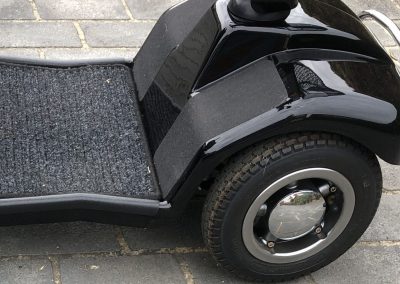
Check Tyres
-
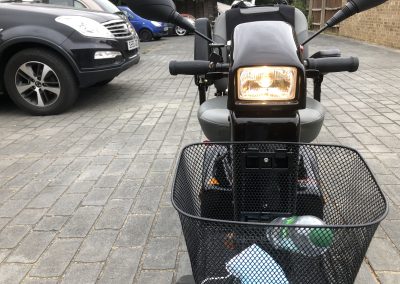
Check Lights
-
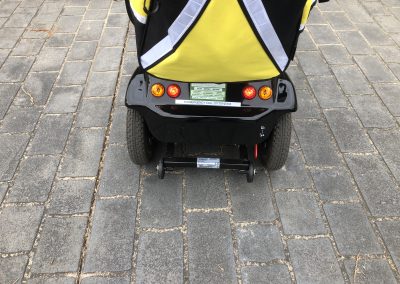
Check Lights
-
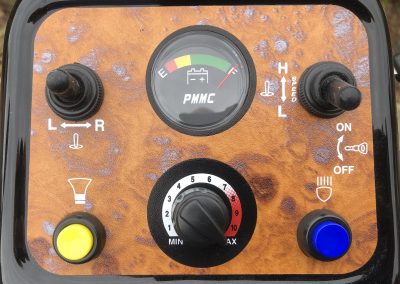
Check Charge
-
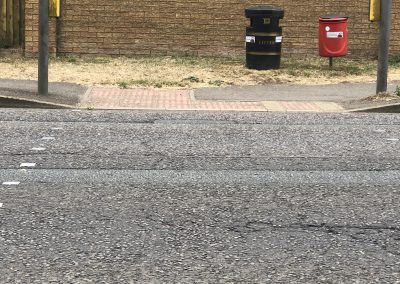
Dropped Kerb
-

Pedestrian Crossing
-

Safe place to cross
Remember, pavements are restricted to 4mph and you must be able to drive at between 5 and 8 mph to be on the road
